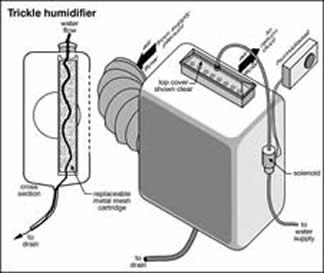|
The outside winter air is cold and dry. The inside winter air is dry. Our chapped lips, dry skin and static zaps from doorknobs remind us of that all season long. Homes like the dry environment, but dry air makes people uncomfortable. While an ideal humidity for homes can be as low as 5%, people prefer about 60% humidity. And because people are more powerful than homes, we add humidifiers to have it our way.
PHYSICS 101
If we asked Einstein what he thought about humidity, he might have said, "It's all relative." Of course, he said that about everything. We typically talk about relative humidity rather than absolute humidity. Relative humidity is the amount of water vapor in the air relative to how much vapor the air can hold before it condenses or rains. For example, a room with 4 pints of water vapor may have a relative humidity of 40%. This means we could have 10 pints of water in the air before the relative humidity reaches 100% and we get rain or condensation.
The interesting part is that if you cool down the air in a room but add no more water vapor, the relative humidity goes up. And, if you warm the air, the relative humidity goes down. This is important because the winter air outside is very cold and dry. When we bring the winter air into our homes and warm it up, we get really dry air in our homes. For example, outdoor air with 80% relative humidity at freezing temperatures will only have 20% relative humidity when we warm it to room temperature.
DO I NEED A HUMIDIFIER?If your house is new, you may not have a humidifier. You may not need one because the foundation and wood framing are still drying out, releasing moisture into the air. Also, new houses are "tight," which means the air within them hangs around for a while before being replaced by dry exterior air. It hangs around long enough to pick up moisture from things like showers, cooking, drying clothes and breathing. By comparison, old houses are drafty. Cold, dry air is creeping in all the time, drying out the home as it flushes the warm moist air out.
DO I HAVE ONE?
If there is a small box like the one in the picture hanging from the furnace or ductwork beside the furnace with a small electrical wire and a small water hose attached, then YES. You may also see the humidistat, a dial that looks like the thermostat but is used to control the humidity level, and is often mounted to the basement ductwo rk. rk.
Trickle type humidifiers have no tray of water. A small electric valve at the top controls the water supply to the humidifier. When the humidistat calls for water, the valve opens, trickling water down a honeycomb-like metal pad. Air blows across the pad, picking up moisture. Excess water is drained through a hose to a floor drain, laundry tub, or condensate pump.
WHAT DO I DO?
 If you have a drum style unit, the tray of sitting water is your nemesis. Ponding water will cause scale build-up and bacterial growth. Every spring, the water supply pipe valve should be turned off, the tray and sponge should be cleaned, and the humidistat should be set to OFF. In the fall, turn on the water valve, and set the humidistat to 35%. We recommend a mid-winter cleaning as well. If you have a drum style unit, the tray of sitting water is your nemesis. Ponding water will cause scale build-up and bacterial growth. Every spring, the water supply pipe valve should be turned off, the tray and sponge should be cleaned, and the humidistat should be set to OFF. In the fall, turn on the water valve, and set the humidistat to 35%. We recommend a mid-winter cleaning as well.
If you have a cascade style unit, turn off the water supply and turn the humidistat to OFF in the spring. Before use in the fall, remove and soak the pad in de-scaling solution. If it is damaged or too clogged to clean, the pad can be replaced. Once the pad is back in place, the water supply pipe valve can be turned back on, and the humidistat set to 35%. This unit will not need cleaning again until next year.
HOW MUCH IS TOO MUCH?
As we said, people like about 60% relative humidity. Unfortunately, houses have a hard time coping with this in cold weather. Too little humidity makes people feel uncomfortable. Too much can cause condensation, mould, mildew, and rot as the warm moist air hits cool surfaces. What confuses many people is that as the weather gets colder, we have to LOWER the humidistat setting, even though we want to raise it. This is because the colder it is outside, the easier it is for condensation to form on cool surfaces like windows. We can reduce condensation by lowering the interior humidity level.
| Outside Temperature | Recommended House Humidity |
| -20° F | 15% |
| -20° F to -10° F | 20% |
| -10° F to 0° F | 25% |
| 0° F to +10° F | 35% |
| +10° F and above | 40% |
| Summer months | Off |
Keeping an eye on the amount of condensation on your windows is another great way to gauge your house humidity level. You can also track things with a room temperature and humidity monitor, available at hardware and building supply stores.
<< Back to Technical Library
|